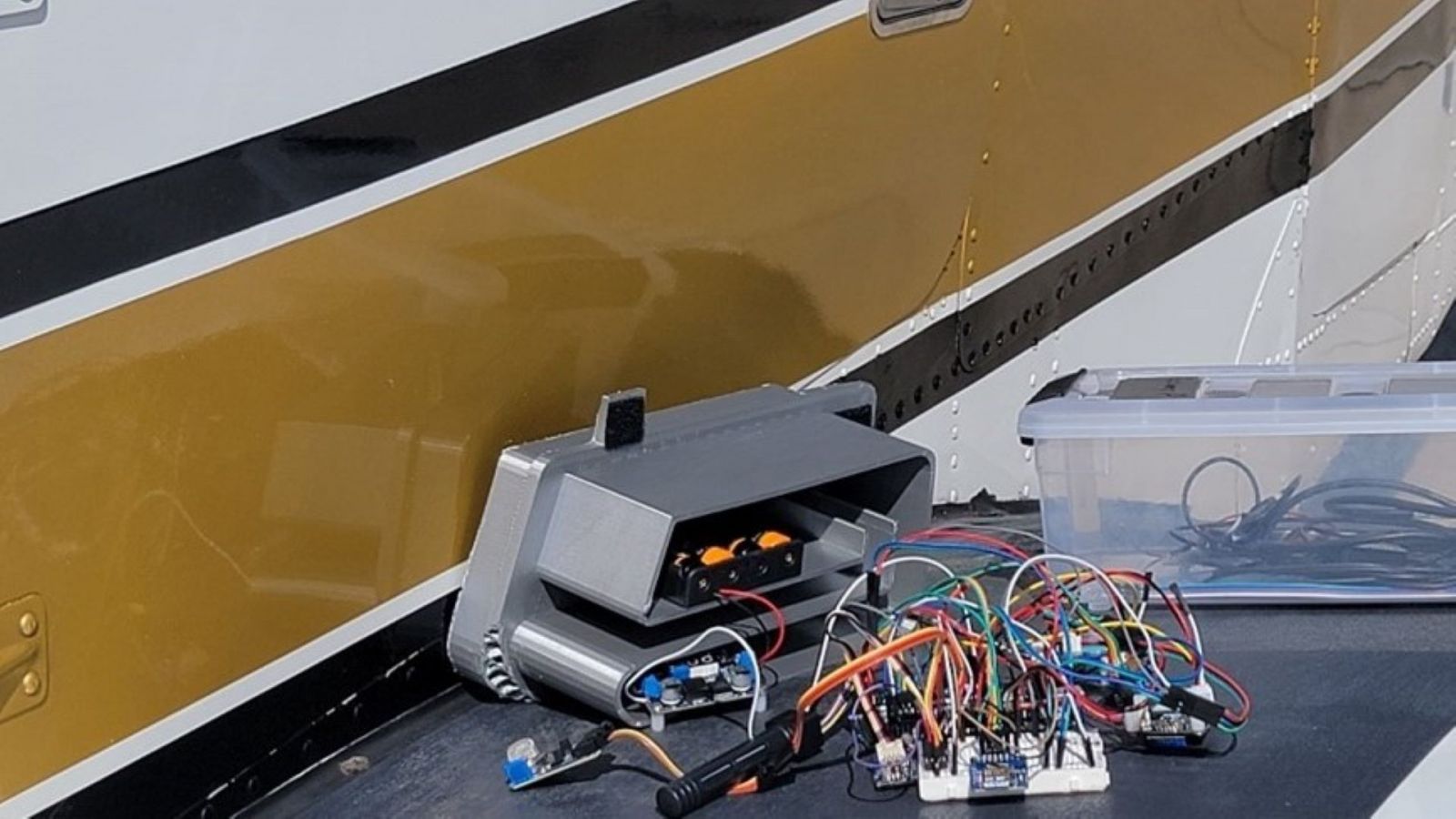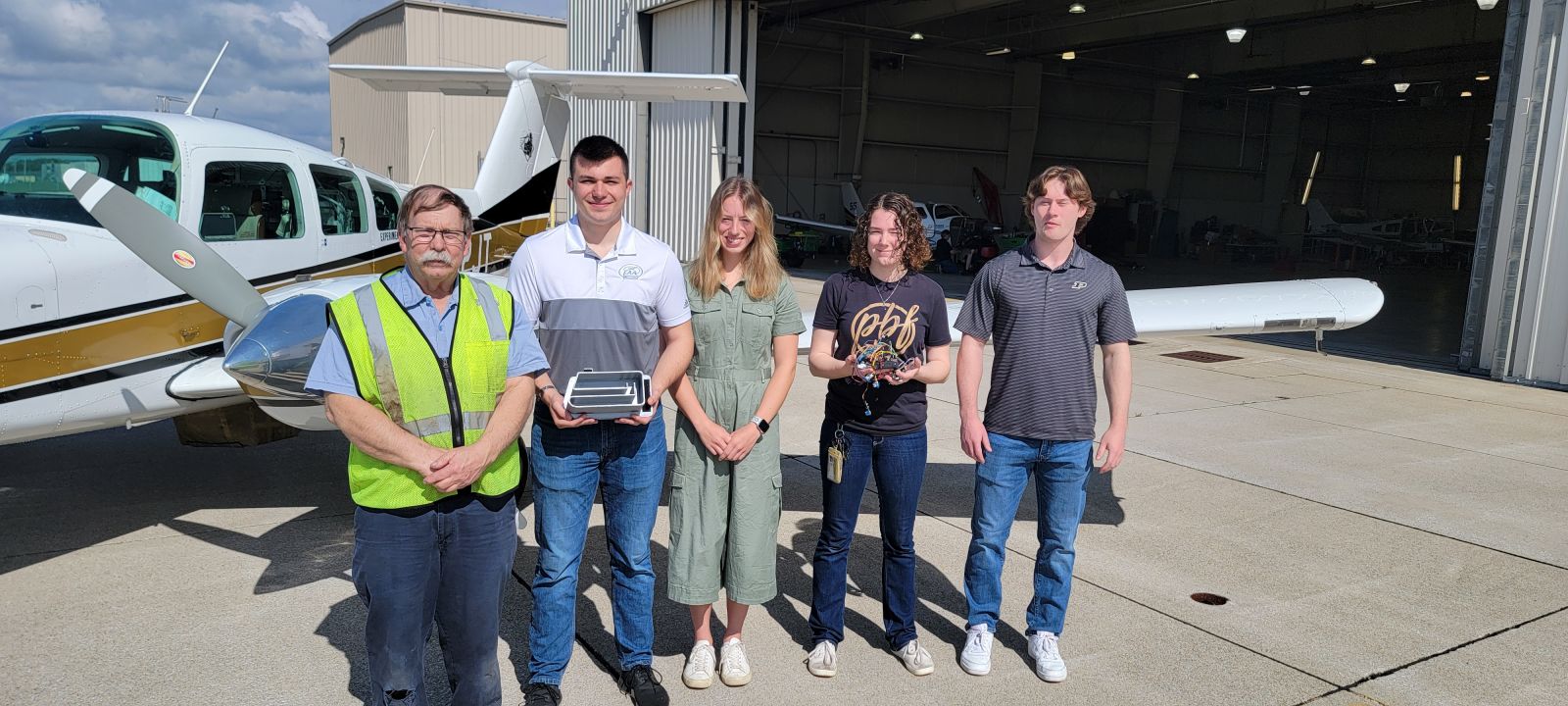
Author’s note: Thank you to faculty member Timothy Ropp for providing crucial details in both background research and reportage for this piece.
On May 1, 2024 a senior design team of four undergraduates successfully flight-tested a portable atmospheric airborne sensor unit designed for sampling methane, CO2, ozone and other parameters important to the study of climate change and emissions.
The team of four was comprised of students from Aeronautical Engineering Technology, alongside Brian Stirm, an air operations technical specialist with School of Aviation and Transportation Technology (SATT), and Nathan Rose, an SATT clinical assistant professor.
The unit launched from the Purdue University airport onboard SATT’s Beech 76 Duchess, an experimental research aircraft used in other atmospheric testing.
The Aeronautical Atmospheric Monitoring Unit (AAMU) was a senior design capstone project for Aeronautical Engineering Technology majors. This senior capstone (AT49700) is taught by Tim Ropp, a clinical professor and research center director at Purdue Polytechnic.

The team collaborated with two of SATT’s flagship research laboratories: Ropp’s Aerospace and MRO Technology Innovation Center and Professor Donald Barnes’ Avionics Lab to source and engineer wiring, components and configurations. This process also involved 3D-printing a new assembly housing for the sensor unit.
They also collaborated with Nathan Rose, a clinical assistant professor who teaches in SATT’s Unmanned Aerial Systems major and has expertise in sensor technologies and atmospheric sciences.

Ropp uses industry-based Technology Readiness Level (TRL) standards as project development benchmarks to guide design, build and testing and for helping in determining final grading.
“Don’t let the size fool you,” Ropp said. “This team experienced first-hand the level of collaboration, persistence and shared expertise required to take a real-world project from a TRL 1, where all you have is a customer’s conceptual vision, to a TRL 6 or higher, where it’s performing in the actual environment.”
Ropp said that there are still almost always bugs and fixes identified during a first test followed by modification and re-testing. “That’s the purpose of testing in the real environment.”
The entire assembly incorporates an array of miniature telemetry sensors for detecting and recording various atmospheric components at mid-level altitudes in real time. It is designed for portability to fit small general aviation aircraft and eventually drones, allowing for use on multiple airborne platforms to obtaining a widespread "web" of atmospheric data.
“Our goal was to build a smaller, airborne, multi-sensor unit, something that could be used at mid-level altitudes,” said seniors Lukas Johnson and Riley Hammond. “[This altitude range] is where satellites can’t always accurately pick up atmosphere readings very well.”
Hammond added: “we want to progress to making the unit adaptable to drone platforms for even more flexibility.”
Asked about the most challenging aspects of the project, senior Claudia Buddenbaum said locating the right sensors was difficult. “Finding sensors that fit the restricted housing areas but still sense and deliver data accurately is challenge. A lot of current methane sensors for example are big. Even portable ones can be the size of a suitcase. We had to balance the tradeoff of size with accuracy.”
Senior Anna Carl added, “Once we got the sensors, it was all about connecting and programming them to talk to each other… communicating the data into something readable and saving that data reliably was a majority of the work.”
“Our climate and how it is changing is extremely important with an almost daily news focus on new developments, including government requirements for monitoring our atmosphere for greenhouse gas emissions worldwide,” said Brian Stirm, the team’s primary customer and mentor.
“This is accomplished at the ground level presently and high above with the satellite network. But it must be expanded into mid-levels of the atmosphere by aviation. Aviation requires a lighter weight, simplified air sampling device that can be installed with minimal effort in existing aircraft as well as the un-piloted aircraft presently being developed. The goal of our student-led research project is to produce a prototype device that can serve this function.
“This device will allow for wide spread use of air sampling due to is extremely low cost and light weigh construction that will easily be adaptable to all types of aircraft from the smallest of drones that are un-piloted to the largest of airline equipment.”
Stirm added: “This device is extremely light weight but demonstrates functionality to locate where the sample is collected by GPS location and height as well as a time stamp for when the sample is collected. All of the integrated sensors digitally record their collection values to the location and time that they were taken. This will allow for post processing of the data leading to a better total emission picture for each flown area. That’s the goal. Individual pilots will be able to use the device and our hope is that it can be incorporated into all the flight training aircraft which are flying at all times.”
The first downloaded flight data readings showed indications that were “a good sign” of the unit’s early function and detection capabilities according to Nathan Rose. Remaining parameters are still being analyzed. Expansion of the device’s capabilities and future test flights are planned.
Additional information
- New avionics lab in development at Purdue Polytechnic (Purdue Polytechnic newsroom)
- Truman Scholarship awards Polytechnic student for outstanding public service, leadership potential (Purdue Polytechnic newsroom)
- Faculty win FAA grant to provide high-tech learn-by-doing programs for aviation educators (Purdue Polytechnic newsroom)
